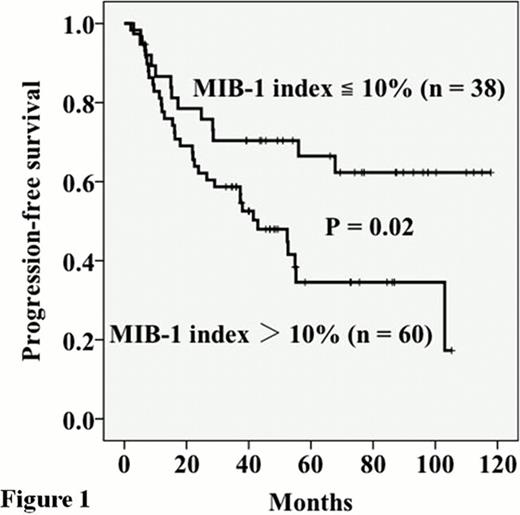Abstract
Abstract 1561
Follicular lymphoma (FL) is an indolent non-Hodgkin lymphoma (NHL), with a highly variable natural history, ranging from an indolent disease to a rapidly progressive disease such as transformation to aggressive NHL. The MIB-1 labeling index, based on the Ki67 immunostaining, is widely used for evaluating the proliferation of tumor cells.
We retrospectively evaluated the prognostic impact of the MIB-1 labeling index at diagnosis in patients with FL treated with rituximab plus cyclophosphamide, doxorubicine, vincristine, and prednisolone (R-CHOP) alone. Ninety-eight consecutive FL patients (48 men and 50 women; median age, 57 years [range, 34–85 years]) were enrolled in one of the 7 participating hospitals between 2001 and 2009. Since 2001, the Yokohama City University Hematology Group in Japan has uniformly treated FL patients with curative intent, except for those in stage 1 disease, with 6 cycles of standard R-CHOP therapy for 21 days. Patients who had partial response (PR) after the 4 initial cycles were administered a total of 8 R-CHOP cycles, whereas patients who did not achieve PR after the 4 initial R-CHOP cycles or those who exhibited disease progression at any given time received salvage therapy. Patients who had a bulky mass defined as any mass exceeding 10 cm in diameter in a horizontal plane or a mediastinal mass with a maximum diameter exceeding one-third of the maximum chest diameter, received additional irradiation following CR with 6–8 cycles of R-CHOP. Patients who required a dose reduction of more than 20% were excluded from this study. The pathological diagnosis and MIB-1 labeling index were reviewed by 3 hematological pathologists (S. S., N. Ts., and K.T.).
The WHO pathological grading in patients was as follows: grade1 in 63 patients, grade 2 in 21 patients, grade 3a in 12 patients, and grade 3b in 2 patients. The median MIB-1 index was 12.9% (range, 0.8%-79.9%). The median observation period for living patients was 59 months. The estimated 5-years progression-free survival (PFS) and 5-years overall survival (OS) rates were 48% and 84%, respectively. Patients with a MIB-1 index above 10% (n = 60) showed inferior survival curves compared with patients with a MIB-1 index below 10% (n = 38) in PFS (5-year PFS of 35% versus 67%, P = 0.02; Figure 1) and OS (5-year OS of 77% versus 94%, P = 0.009), respectively. Pathological grading was not correlated with PFS and OS. The following variables were assessed for their impact on PFS: (1) gender, (2) age > 60 years, (3) elevated serum lactate dehydrogenase level, (4) advanced clinical stage, (5) pathological grade, and (6) a MIB-1 labeling index above 10%. A MIB-1 labeling index above 10% was independently associated with poor PFS (P = 0.01, RR = 2.6), as well as advanced clinical stage (P = 0.004, RR = 2.7).
A MIB-1 labeling index of above 10% is a useful prognostic factor in FL treated by R-CHOP.
No relevant conflicts of interest to declare.
Author notes
Asterisk with author names denotes non-ASH members.


